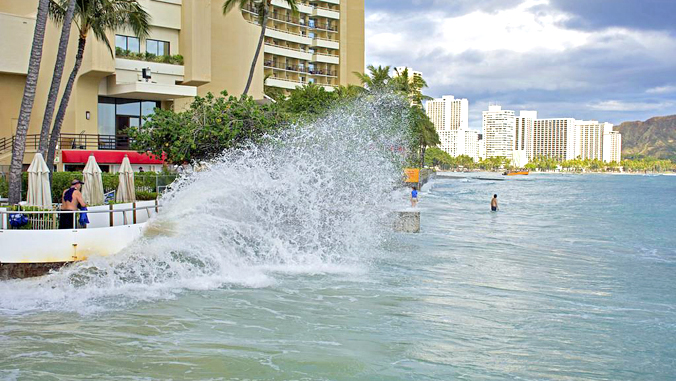This column written by University of Hawaiʻi at Mānoa’s Makena Coffman, an urban and regional planning professor and chair of the Honolulu Climate Change Commission, and Chip Fletcher, associate dean of the School of Ocean and Earth Science and Technology and vice chair of the commission, ran in the Honolulu Star Advertiser on October 14, 2018. The commission gathers the latest science and information on climate change impacts to Hawaiʻi to provide policy recommendations to the mayor, City Council and city departments.



Prior to Hurricane Lane making a run at our island, the city’s Honolulu Climate Change Commission officially released two documents describing the impact of a warmer world.
The first, Climate Change Brief, lays out the trajectory of the climate threat, and the risks to Oʻahu. The second, Sea Level Rise Guidance, explains the projected impact and timeline of rising seas around Oʻahu, and makes recommendations for action:
- Plan for 3.2 feet (1 meter) of sea level rise by the end of the century, with the potential for 6 feet (1.8 meter) of rise if we don’t radically reduce global carbon emissions now.
- Plan for disruptive high tide flooding by mid-century.
High-tide flooding causes storm drains to back-flow onto roads, the water table to rise through the ground, and rain to pond and flood. Beaches erode, waves reach into homes, and coastal roads are overwashed and undermined. We began to see such effects during the summer 2017 “king tides.”
The commission recommends taking key actions now to be as prepared as possible when large impacts arrive. We appreciate the quick action by Mayor Kirk Caldwell, who issued a formal directive in July to all city departments and agencies in direct response to our recommendations.
We also appreciate the many city departments that came to testify in front of our commission with their plans and actions. Among them: the Honolulu Board of Water Supply, which has initiated a climate adaptation plan; the Department of Facility Maintenance, which is evaluating storm water solutions; the Department of Environmental Services with concerns about wastewater treatment; the Department of Planning and Permitting with worries about coastal erosion and adapting for sea level rise; and, HART, which has pro-actively studied sea level rise and made recommendations about raising station areas and critical infrastructure to avoid future flood levels.
While our kuleana is to inform the city, the reality is that climate change threatens all of Hawaiʻi’s beaches, coastal communities and shoreline infrastructure, including airports, harbors and roads.
With rising seas, beaches will migrate landward. If this migration is not allowed, beaches will disappear. Infrastructure will be flooded, stressing their engineered capacity, and we must make tough decisions as a community to determine what investments can and should be made, and where.
What is already clear: sea level rise has made many of our current policies and assumptions around shoreline development out of date. Our coastal communities were and continue to be designed and built for a climate and ocean level that no longer exists. For the health and survival of our natural resources, including beaches, and the safety of people and structures, this must change.
The negative impacts of climate change poised to hit Oʻahu — drought, flooding, sea level rise, heat stress, disease, and yes, larger and more powerful hurricanes approaching along new pathways — can be reduced. The faster we and the globe eliminate fossil fuels from the economy, the less adaptation we and our children will endure over coming decades.
Ask yourself, “What can I do to increase sustainability and resiliency in Hawaiʻi?” Some suggestions:
- Reduce your consumption and waste.
- Decarbonize your travel: drive and fly less, choose mass transit or take up biking.
- Decarbonize your diet with more locally grown vegetables.
- Serve the community: Help plant trees and remove invasive species, adopt a beach or park, join a community service organization.
- Use your vote to position legislation and policies to make Oʻahu a climate-ready community.
- Communicate concern about climate change with others.
We are fortunate to live in a state where the science of climate change is accepted and generally understood. Let’s take advantage of this awareness, and our collaborative spirit, to catch-up on climate change.
We need to eliminate dangerous fossil fuels, plan for more frequent and intense weather hazards, and adapt to sea level rise. Now is the time for new policies and behaviors to protect our most treasured places.
Related UH News stories:
- UH-led Honolulu commission issues sea-level and climate-change guidance, July 16, 2018
- UH experts appointed to city climate change commission, January 31, 2018

